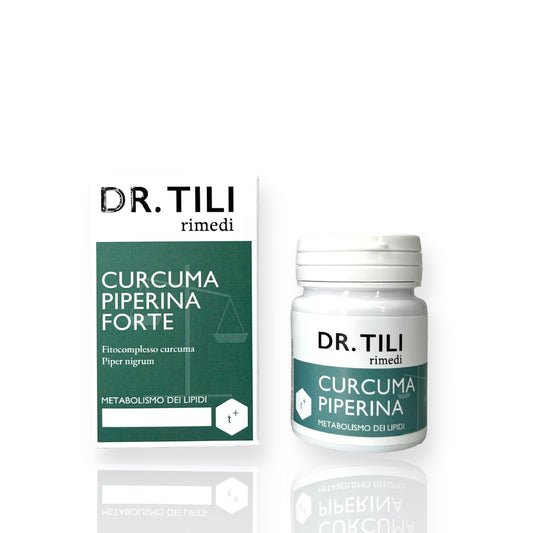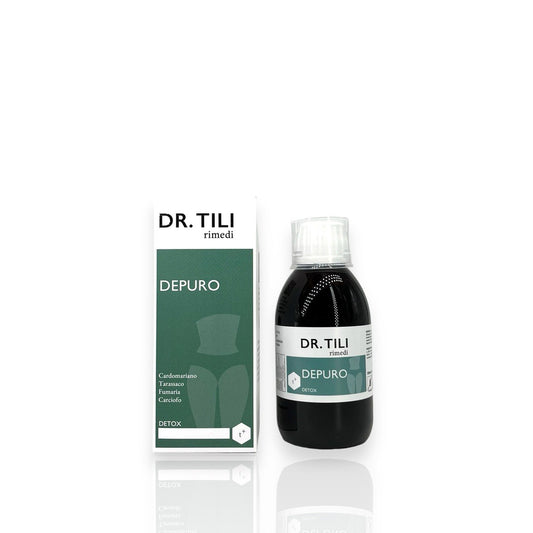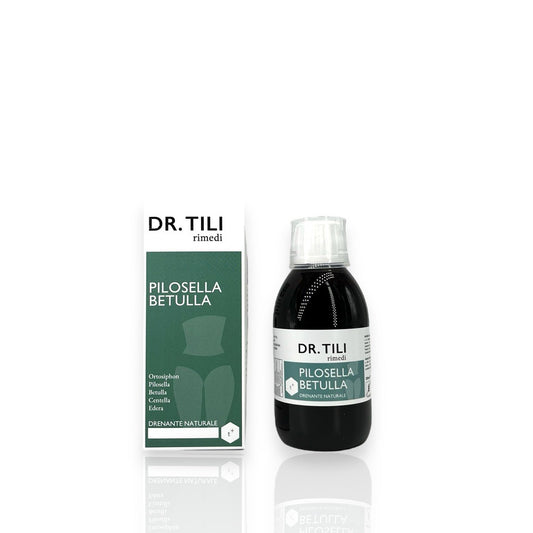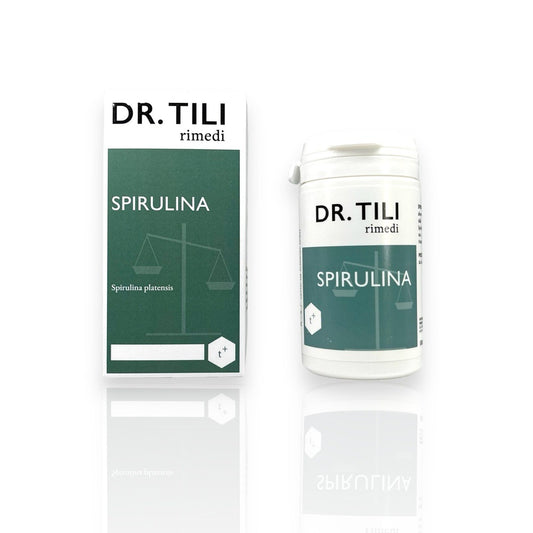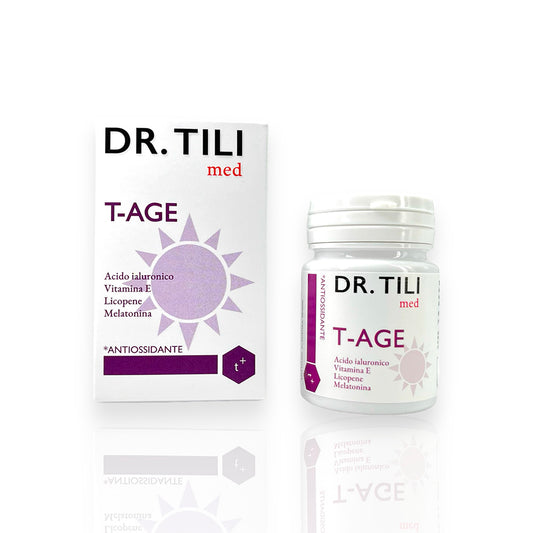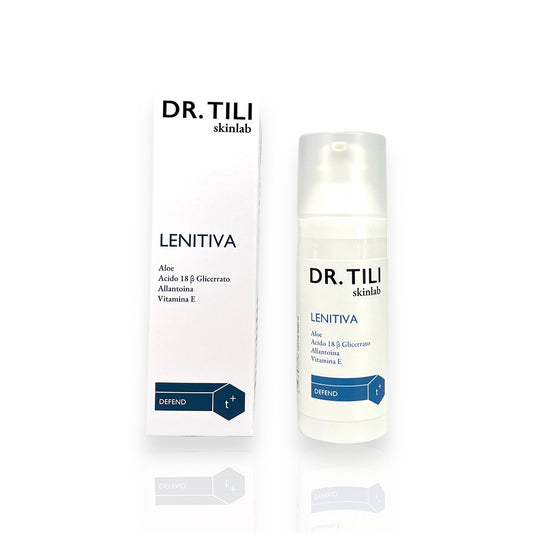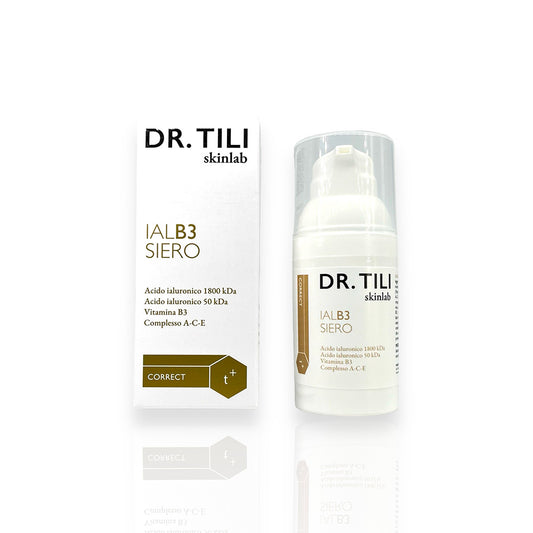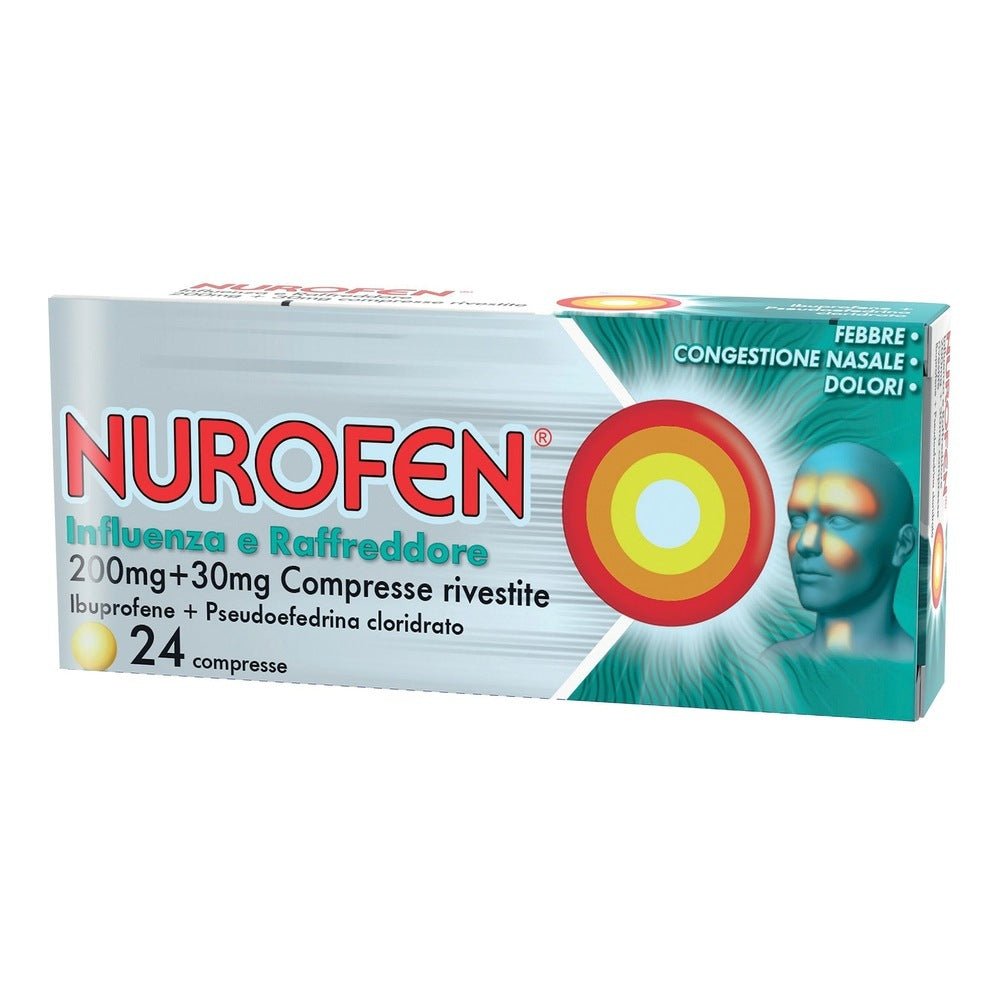RECKITT BENCKISER H.(IT.) SpA
Nurofen Cold and Flu 200mg + 30mg 24 coated tablets
Nurofen Cold and Flu 200mg + 30mg 24 coated tablets

Pickup available at Farmacia Tili
Usually ready in 24 hours
PRODUCT NET WEIGHT
PRODUCT NET WEIGHT
EAN
EAN
034246025
MINSAN
MINSAN
034246025
Nurofen Flu and Cold is a combination drug based on ibuprofen (200mg) and pseudoephedrine hydrochloride (30mg), indicated for the symptomatic treatment of flu, cold and nasal congestion . Thanks to the synergistic action of its active ingredients, it helps reduce pain, fever and inflammation , while pseudoephedrine acts as a nasal decongestant , promoting freer breathing.
The coated tablets are easy to swallow and well tolerated, ideal for relieving symptoms such as headache, muscle pain, nasal congestion, fever and fatigue . The 24-tablet format allows for a practical and effective treatment to deal with seasonal ailments with a single solution.
ACTIVE INGREDIENTS
Active ingredients contained in Nurofen Cold and Flu 200mg + 30mg 24 coated tablets - What is the active ingredient in Nurofen Cold and Flu 200mg + 30mg 24 coated tablets?
One tablet contains: Ibuprofen 200 mg, Pseudoephedrine hydrochloride 30 mg Excipients with known effect: sodium, sunset yellow FCF colouring (E 110). For the full list of excipients, see section 6.1.
EXCIPIENTS
Composition of Nurofen Cold and Flu 200mg + 30mg 24 coated tablets - What does Nurofen Cold and Flu 200mg + 30mg 24 coated tablets contain?
Tricalcium phosphate, sodium carboxymethylcellulose, microcrystalline cellulose, povidone, methylhydroxypropylcellulose, magnesium stearate, talc, colourants: E 104, E 110, E 171.
DIRECTIONS
Therapeutic indications Nurofen Cold and Flu 200mg + 30mg 24 coated tablets - Why is Nurofen Cold and Flu 200mg + 30mg 24 coated tablets used? What is it used for?
NUROFEN FLU AND COLD 200 mg + 30 mg Coated Tablets, is indicated in adults and adolescents over 12 years. Treatment of cold and flu symptoms such as nasal and sinus congestion, aches, fever, sore throat, headache.
CONTRAINDICATIONS SIDE EFFECTS
Contraindications Nurofen Flu and Cold 200mg + 30mg 24 coated tablets - When should Nurofen Flu and Cold 200mg + 30mg 24 coated tablets not be used?
Hypersensitivity to the active substances or to any of the excipients listed in section 6.1. Patients with peptic ulcer. History of gastrointestinal bleeding or perforation related to previous active treatments or history of recurrent peptic ulcer/haemorrhage (two or more distinct episodes of proven ulceration or bleeding). Subjects who have previously shown hypersensitivity reactions (such as nasal polyposis, asthma, rhinitis, angioedema or urticaria) following the use of ibuprofen, acetylsalicylic acid or other analgesics, antipyretics, other non-steroidal anti-inflammatory drugs (NSAIDs). Severe renal or hepatic insufficiency. Severe cardiac insufficiency (NYHA class IV). Patients with serious cardiovascular disease, tachycardia, hypertension, angina pectoris, hyperthyroidism, diabetes, pheochromocytoma, glaucoma, prostatic syndrome. Pregnancy. Breastfeeding (see section 4.6). Children under 12 years. Patients taking or who have taken in the previous 14 days monoamine oxidase inhibitors (MAOIs) (see section 4.5).
DOSAGE
Quantity and method of taking Nurofen Flu and Cold 200mg + 30mg 24 coated tablets - How to take Nurofen Flu and Cold 200mg + 30mg 24 coated tablets?
Dosage For short-term treatment only. • Maximum 5 days of therapy for the adult population; • Maximum 3 days of therapy for the paediatric population (12-18 years). Undesirable effects can be minimised by using the lowest effective dose for the shortest duration of treatment necessary to control symptoms (see section 4.4). If the use of the medicinal product is necessary for more than 5 days in adults and for more than 3 days in adolescents, or in case of worsening of symptoms, a doctor must be consulted. Paediatric population : Do not administer to children under 12 years of age. Adults and adolescents over 12 years of age : The initial dose is 1-2 tablets per day, then, if necessary, 1-2 tablets every 4 hours. Do not exceed the dose of 6 tablets in 24 hours. Elderly : No changes to the recommended dosage are required in the elderly except in patients with renal or hepatic impairment for whom the dosage must be individually adapted. Method of administration : Oral use.
CONSERVATION
Storage Nurofen Cold and Flu 200mg + 30mg 24 coated tablets - How do you store Nurofen Cold and Flu 200mg + 30mg 24 coated tablets?
This medicinal product does not require any special storage conditions.
WARNINGS
Warnings Nurofen Flu and Cold 200mg + 30mg 24 coated tablets - About Nurofen Flu and Cold 200mg + 30mg 24 coated tablets it is important to know that:
Undesirable effects may be minimised by using the lowest effective dose for the shortest duration necessary to control symptoms (see section 4.2 and the sections below on Gastrointestinal and cardiovascular risks). Other NSAIDs: The use of NUROFEN FLU AND COLD should be avoided in conjunction with NSAIDs, including selective COX-2 inhibitors. Avoid the simultaneous use of two or more analgesics, antipyretics, non-steroidal anti-inflammatory drugs, as this increases the risk of undesirable effects. The use of NSAIDs should be carefully considered in patients with coagulation disorders as a reduction in coagulability is possible. The same applies to patients treated with oral anticoagulants, due to the possibility of an enhancement of the anticoagulant effect (see also section 4.5). Gastrointestinal safety: As with all anti-inflammatory drugs, the drug should not be taken if the patient suffers from ulcers or gastric disorders. Gastrointestinal bleeding, ulceration and perforation: Gastrointestinal bleeding, ulceration and perforation, which can be fatal, have been reported with all NSAIDs at anytime during treatment, with or without warning symptoms or a previous history of serious GI events. The risk of GI bleeding, ulceration or perforation is higher with increasing NSAID doses, in the elderly and in patients with a history of ulcer, particularly if complicated with haemorrhage or perforation (see section 4.3). These patients should start treatment on the lowest dose available. Concomitant use of protective agents (e.g. misoprostol or proton pump inhibitors) should be considered for these patients, and also for patients requiring concomitant low dose acetylsalicylic acid or other drugs likely to increase gastrointestinal risk (see section 4.5 below). Patients with a history of GI toxicity, particularly when elderly, should report any unusual GI symptoms (especially GI bleeding) particularly in the initial stages of treatment. Caution should be advised in patients receiving concomitant medications which could increase the risk of ulceration or bleeding, such as oral corticosteroids, anticoagulants such as warfarin, selective serotonin reuptake inhibitors or anti-platelet agents such as acetylsalicylic acid (see section 4.5). If GI bleeding or ulceration occurs in patients receiving NUROFEN FLU AND COLD, the treatment should be withdrawn. NSAIDs should be given with caution to patients with a history of gastrointestinal disease (ulcerative colitis, Crohn's disease) as these conditions may be exacerbated (see section 4.8). Cardiovascular and cerebrovascular effects: Caution is advised (discuss with your doctor or pharmacist) before initiating treatment in patients with a history of hypertension and/or heart failure since fluid retention, hypertension and oedema have been reported in association with NSAID treatment. Clinical trials suggest that use of ibuprofen, particularly at high doses (2400 mg/day), may be associated with a small increased risk of arterial thrombotic events (e.g. myocardial infarction or stroke). Overall, epidemiological studies do not suggest that low doses of ibuprofen (e.g. ≤ 1200 mg/day) are associated with an increased risk of arterial thrombotic events. Patients with uncontrolled hypertension, congestive heart failure (NYHA II-III), established ischaemic heart disease, peripheral arterial disease, and/or cerebrovascular disease should be treated with ibuprofen only after careful consideration and high doses (2400 mg/day) should be avoided. Careful consideration should also be exercised before initiating long-term treatment of patients with risk factors for cardiovascular events (e.g. hypertension, hyperlipidaemia, diabetes mellitus, smoking), particularly if high doses (2400 mg/day) of ibuprofen are required. Skin reactions: Serious skin reactions, some of them fatal, including exfoliative dermatitis, Stevens-Johnson syndrome, and toxic epidermal necrolysis, have been reported very rarely in association with the use of NSAIDs (see section 4.8). Patients appear to be at highest risk in the early stages of therapy: the onset of the reaction occurs in the majority of cases in the early stages of treatment. NUROFEN FLU AND COLD should be discontinued at the first appearance of skin rash, mucosal lesions or any other sign of hypersensitivity. Severe skin reactions: Severe skin reactions, such as acute generalised exanthematous pustulosis (AGEP), may occur with medicinal products containing ibuprofen and pseudoephedrine. This acute pustular eruption may occur within the first 2 days of treatment, with fever and numerous, small, mostly non-follicular pustules arising from widespread oedematous erythema and located mainly in the skin folds, trunk and upper limbs. Patients should be carefully monitored. If signs and symptoms such as pyrexia, erythema or numerous small pustules are observed, Nurofen Flu and Cold should be discontinued and appropriate measures taken if necessary. Respiratory disorders: bronchospasm may occur in patients with bronchial asthma or current or previous allergic diseases. Do not take the product in cases of asthma and allergy to acetylsalicylic acid without consulting your doctor (see section 4.3). SLE and mixed connective tissue disease: in case of systemic lupus erythematosus and mixed connective tissue disease it may lead to an increased risk of aseptic meningitis (see section 4.8). Renal function: renal insufficiency, as renal function may be impaired (see sections 4.3 and 4.8). Hepatic function: liver dysfunction (see sections 4.3 and 4.8). Impaired female fertility: see section 4.6 regarding female fertility. To be used with caution in combination with antihypertensives including adrenergic neuronal blockers and beta blockers (see section 4.5). To be used with caution with other sympathomimetic agents such as decongestants, appetite suppressants and amphetamine psychostimulants (see section 4.5). To be used with caution in case of hyperexcitement. If hallucinations, restlessness or sleep disturbances occur during administration of the medicinal product, the use of the medicinal product should be discontinued. Elderly: Elderly patients have an increased frequency of adverse reactions to NSAIDs, in particular gastrointestinal bleeding and perforation which may be fatal (see section 4.2). Paediatric population: There is a risk of impaired renal function in dehydrated adolescents. Ischemic colitis: Some cases of ischemic colitis have been reported with pseudoephedrine. If sudden abdominal pain, rectal bleeding or other symptoms of ischemic colitis develop, pseudoephedrine should be discontinued and a physician should be consulted. Ischemic optic neuropathy Cases of ischemic optic neuropathy have been reported with pseudoephedrine. Pseudoephedrine should be discontinued if sudden loss of vision or reduction in visual acuity occurs, for example in the case of scotoma. Masking of symptoms of underlying infections Nurofen Cold & Flu may mask the symptoms of infection, which may delay initiating adequate treatment and therefore worsen the outcome of the infection. This has been observed in community-acquired bacterial pneumonia and bacterial complications of chickenpox. When Nurofen Cold & Flu is given for the relief of infection-related fever or pain, monitoring for the infection is advised. In non-hospital settings, the patient should seek medical advice if symptoms persist or worsen. This medicine contains: • less than 1 mmol sodium (23 mg) per tablet, i.e. essentially “sodium-free”; • sunset yellow FCF (E 110) , which may cause allergic reactions.
INTERACTIONS
Interactions Nurofen Influenza and Cold 200mg + 30mg 24 coated tablets - Which medicines or foods can modify the effect of Nurofen Influenza and Cold 200mg + 30mg 24 coated tablets?
Anticoagulants: NSAIDs may enhance the effects of anticoagulants, such as warfarin (see section 4.4). Antiplatelet agents and selective serotonin reuptake inhibitors (SSRIs): increased risk of gastrointestinal bleeding (see section 4.4). Corticosteroids: increased risk of gastrointestinal ulceration or bleeding (see section 4.4). The product should not be taken by patients receiving monoamine oxidase inhibitors and for 14 days after cessation of such treatment. The product may enhance the effect of other sympathomimetic agents, such as decongestants. The effect of pseudoephedrine may be reduced by guanethidine, reserpine and methyldopa and may be influenced by tricyclic antidepressants. In turn, pseudoephedrine may reduce the effect of guanethidine and may increase the possibility of arrhythmias in digitalized patients, or in patients taking anticholinergics (including tricyclic antidepressants) or quinidine. Diuretics, ACE inhibitors and Angiotensin II Antagonists: NSAIDs may reduce the effect of diuretics and other antihypertensive drugs. In some patients with compromised renal function (for example dehydrated patients or elderly patients with compromised renal function) the co-administration of an ACE inhibitor or an angiotensin II antagonist and agents that inhibit the cyclo-oxygenase system may lead to further deterioration of renal function, including possible acute renal failure, which is usually reversible. These interactions should be considered in patients taking NUROFEN INFLUENZA E RAFFREDDORE concomitantly with ACE inhibitors or angiotensin II antagonists. Therefore, the combination should be administered with caution, especially in elderly patients. Patients should be adequately hydrated and consideration should be given to monitoring renal function after initiation of concomitant therapy. Acetylsalicylic acid: Concomitant administration of ibuprofen and acetylsalicylic acid is generally not recommended due to the potential for increased adverse effects (see section 4.4). Experimental data suggest that ibuprofen may competitively inhibit the effect of low-dose acetylsalicylic acid on platelet aggregation when the drugs are administered concomitantly. Although there are uncertainties regarding extrapolation of these data to the clinical situation, the possibility that regular, long-term use of ibuprofen may reduce the cardioprotective effect of low-dose acetylsalicylic acid cannot be excluded. No clinically relevant effect is considered likely following occasional use of ibuprofen (see section 5.1). Other NSAIDs including cyclooxygenase-2 selective inhibitors: Concomitant use of two or more NSAIDs should be avoided as it may increase the risk of adverse events (see section 4.4). Cardiac glycosides: NSAIDs may worsen heart failure, reduce GFR (glomerular filtration rate) and plasma glycoside levels. Lithium: There is evidence of the possibility of a potential increase in lithium levels in the blood. Methotrexate: There is evidence of the possibility of an increase in plasma levels of methotrexate. Ciclosporins: Increased risk of nephrotoxicity. Mifepristone: NSAIDs cannot be administered for 8-12 days after mifepristone administration as NSAIDs may reduce the effect of mifepristone. Tacrolimus: Possible increased risk of nephrotoxicity when NSAIDs are administered with tacrolimus. Zidovudine: Increased risk of haematological toxicity when NSAIDs are used concomitantly with Zidovudine. There is evidence of an increased risk of haemarthrosis and haematoma in HIV-seropositive haemophilic patients when treated concomitantly with zidovudine and ibuprofen. Quinolone antibiotics: Data from animal studies indicate that NSAIDs may increase the risk of convulsions associated with quinolone antibiotics. Patients taking NSAIDs and quinolones may be at increased risk of developing convulsions. Ergot alkaloids (ergotamine and methysergide): Increased risk of ergotism. Appetite suppressants (anorexigents) and amphetamine-like psychostimulants: Risk of hypertension. Oxytocin: Risk of hypertension.
SIDE EFFECTS
Like all medicines, Nurofen Cold and Flu 200mg + 30mg 24 coated tablets can cause side effects - What are the side effects of Nurofen Cold and Flu 200mg + 30mg 24 coated tablets?
The following list of undesirable effects includes those that have been observed during treatment with ibuprofen at self-medication doses (up to a maximum of 1200 mg per day) and with sympathomimetics including pseudoephedrine for short periods of administration. Undesirable effects associated with the administration of ibuprofen and sympathomimetics such as pseudoephedrine are listed below by system organ class and frequency. For the frequency of occurrence of undesirable effects, the following expressions are used: Very common ( ≥ 1/10) Common ( ≥ 1/100, <1/10) Uncommon ( ≥ 1/1000, <1/100) Rare ( ≥ 1/10,000, <1/1000) Very rare (<1/10,000) Not known (frequency cannot be estimated from the available data) Within each frequency grouping, undesirable effects are presented in decreasing order of seriousness. Table of undesirable effects
| Classification by systems and organs | Frequency | Adverse Reaction |
| Pathologies of the haemolymphopoietic system | Uncommon | Hypersensitivity reactions characterized by urticaria and pruritus² |
| Very rare | Haematopoietic disorders¹. Severe hypersensitivity reactions. Symptoms may include: swelling of the face, tongue and larynx, dyspnoea, tachycardia, hypotension (anaphylaxis, angioedema or severe shock).² | |
| Psychiatric disorders | Not known | Insomnia, anxiety, restlessness, agitation, hallucinations. |
| Nervous system disorders | Uncommon | Headache, tremors |
| Very rare | Aseptic meningitis³ | |
| Eye pathologies | Not known | Ischemic optic neuropathy |
| Heart disease | Not known | Heart failure and edema 4 , tachycardia, chest pain, arrhythmia, palpitations. |
| Vascular pathologies | Not known | Hypertension 4 |
| Respiratory, thoracic and mediastinal pathologies | Not known | Respiratory system reactivity including asthma, bronchospasm or dyspnoea² |
| Gastrointestinal disorders | Uncommon | Abdominal pain, nausea and dyspepsia 5 |
| Rare | Diarrhea, flatulence, constipation and vomiting | |
| Very rare | Peptic ulcer, perforation or gastrointestinal bleeding, melaena, haematemesis, sometimes fatal, particularly in the elderly (see section 4.4). Ulcerative stomatitis, mouth ulceration, gastritis. | |
| Not known | Dry mouth. Exacerbation of colitis and Crohn's disease (see section 4.4). Ischemic colitis. | |
| Hepatobiliary pathologies | Very rare | Liver disorders |
| Skin and subcutaneous tissue disorders | Uncommon | Skin rashes ² |
| Very rare | Bullous reactions including Stevens-Johnson syndrome, erythema multiforme, and toxic epidermal necrolysis may occur. | |
| Not known | Hyperhidrosis. Drug reaction with eosinophilia and systemic symptoms (DRESS syndrome). Severe skin reactions, including acute generalized exanthematous pustulosis (AGEP). Photosensitivity reactions | |
| Musculoskeletal and connective tissue disorders | Not known | Muscle weakness |
| Kidney and urinary disorders | Very rare | Severe renal failure 6 |
| Not known | Urinary retention | |
| Systemic disorders and conditions related to the administration site | Not known | Irritability, thirst |
| Diagnostic tests | Very rare | Decrease in the level of hemoglobin in the blood |
Description of some adverse reactions 1) Examples of haematopoietic disorders include anaemia, leucopenia, thrombocytopenia, pancytopenia and agranulocytosis. Early symptoms are fever, sore throat, superficial mouth ulcers, flu-like symptoms, severe tiredness, unexplained bleeding and bruising. 2) Hypersensitivity reactions: These reactions include a) non-specific allergic reactions and anaphylaxis, b) respiratory tract reactivity including asthma, worsening of asthma, bronchospasm or dyspnoea or c) various skin conditions such as various rashes, pruritus, urticaria, purpura, angioedema and very rarely bullous and exfoliative dermatitis including toxic epidermal necrolysis, Stevens-Johnson syndrome and erythema multiforme, d) cross-reactivity reactions with pseudoephedrine 3) The pathogenesis of drug-induced aseptic meningitis is not fully understood. However, available data on aseptic meningitis related to the administration of NSAIDs suggest an immune hypersensitivity reaction (due to a temporary relationship with the drug intake and the disappearance of symptoms after discontinuation of treatment). Of note, single cases of aseptic meningitis symptoms (such as stiff neck, headache, nausea, vomiting, fever and disorientation) have been observed during treatment with ibuprofen in patients with autoimmune disorders (such as systemic lupus erythematosus, mixed connective tissue disease). 4) Clinical studies suggest that use of ibuprofen, particularly at high doses (2400 mg/day) may be associated with a modest increased risk of arterial thrombotic events (for example myocardial infarction or stroke) (see section 4.4). 5) Gastrointestinal: the most commonly observed adverse events are gastrointestinal in nature. Peptic ulcers, perforation or gastrointestinal bleeding, sometimes fatal, particularly in the elderly, may occur (see section 4.4). 6) Especially during long-term treatment, associated with increased serum urea and edema. Also includes papillary necrosis. Gastrointestinal intolerance, haemorrhages, sweating, dizziness, precordial pain, difficulty in urination and insomnia may occur. Reporting of suspected adverse reactions Reporting suspected adverse reactions that occur after authorisation of the medicinal product is important. It allows continued monitoring of the benefit/risk balance of the medicinal product. Healthcare professionals are asked to report any suspected adverse reactions via the national reporting system at: https://www.aifa.gov.it/content/segnalazioni-reazioniavverse.
OVERDOSE
Overdose Nurofen Flu and Cold 200mg + 30mg 24 coated tablets - What are the risks of Nurofen Flu and Cold 200mg + 30mg 24 coated tablets in case of overdose?
Symptoms Nausea, vomiting, abdominal pain and, more rarely, diarrhoea may occur. Tinnitus, headache and gastrointestinal bleeding may also occur. In more severe cases of poisoning, central nervous system toxicity is observed, manifesting as dizziness, drowsiness, occasionally excitement and disorientation or coma. Occasionally, patients develop convulsions. In cases of severe poisoning, metabolic acidosis and a prolongation of prothrombin time/INR may occur, probably caused by interference with the action of circulating clotting factors. Acute renal failure, liver damage and respiratory depression may also occur. In asthmatic subjects, exacerbation of asthma may occur. As with other sympathomimetics, an overdose of pseudoephedrine may cause symptoms related to central nervous system disorders and cardiovascular stimulation, including : irritability, restlessness, tremors, thirst, blurred vision, anxiety, insomnia, fever, sweating, exophthalmos, hallucinations, muscle weakness , palpitations, convulsions, urinary retention, hypertension, difficulty urinating, nausea, vomiting, tachycardia, and cardiac arrhythmias. Treatment Treatment should be symptomatic and supportive, particularly with respect to the cardiovascular and respiratory systems, and should include maintaining a patent airway and monitoring cardiac function and vital signs until the patient is stabilized. Oral administration of activated charcoal should be considered if the patient presents within 1 hour of ingesting a potentially toxic amount. Corrective serum electrolyte management should be considered if necessary. Convulsions should be treated with intravenous benzodiazepines if frequent or prolonged. Bronchodilators should be given in asthma. Elimination of pseudoephedrine may be accelerated by acid diuresis or dialysis. Hypertensive phenomena may be treated with alpha-blocking agents IV. Cardiac arrhythmias may require the use of beta-adrenergic blocking agents after administration of alpha-adrenergic blockers. Hyperexcitability and hallucinations may be treated with chlorpromazine.
PREGNANCY AND BREASTFEEDING
If you are pregnant or breast-feeding, think you may be pregnant or are planning to have a baby, ask your doctor for advice before taking Nurofen Cold and Flu 200mg + 30mg 24 coated tablets.
The product should not be used during pregnancy and breastfeeding. Pregnancy: Inhibition of prostaglandin synthesis may adversely affect pregnancy and/or embryo/fetal development. Results of epidemiological studies suggest an increased risk of miscarriage and cardiac malformation and gastroschisis after use of a prostaglandin synthesis inhibitor in early pregnancy. The absolute risk of cardiac malformations increased from less than 1% to approximately 1.5%. The risk was considered to increase with dose and duration of therapy. In animals, administration of prostaglandin synthesis inhibitors has been shown to result in increased pre- and post-implantation loss and embryo-fetal mortality. In addition, an increased incidence of various malformations, including cardiovascular, has been reported in animals administered prostaglandin synthesis inhibitors during the organogenetic period. During the third trimester of pregnancy, all prostaglandin synthesis inhibitors may expose the fetus to: - cardiopulmonary toxicity (with premature closure of the ductus arteriosus and pulmonary hypertension); - renal dysfunction which may progress to renal failure with oligo-hydroamniosis; The mother and the newborn, at the end of pregnancy, to: - possible prolongation of bleeding time, an anti-aggregating effect which may occur even at very low doses; - inhibition of uterine contractions resulting in delayed or prolonged labor. There is a possibility of an association between the onset of fetal anomalies and the intake of pseudoephedrine in the first trimester of pregnancy. Breastfeeding: Although ibuprofen is present in breast milk in very low concentrations, pseudoephedrine is secreted into the milk in significant quantities; for this reason the product should not be used during breastfeeding. Fertility: As with other NSAIDs, the use of NUROFEN FLU AND COLD may impair female fertility by affecting ovulation. It is therefore not recommended in women attempting to conceive.
DRIVING AND USE OF MACHINERY
Taking Nurofen Cold & Flu 200mg + 30mg 24 coated tablets before driving or using machines - Does Nurofen Cold & Flu 200mg + 30mg 24 coated tablets affect driving or using machines?
Not relevant



